



Chameleon Acclimation
By Jason Descamps
Citation:
Descamps, J. (2004). Chameleon Acclimation. Chameleons! Online E-Zine, November 2004. (http://www.chameleonnews.com/04NovDescamps.html)
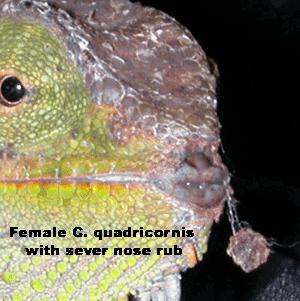
When buying a chameleon, whether in person or via the internet, proper acclimation could be the difference between success and failure. Chameleons are creatures that react very poorly to changes in their habitat. Moving your chameleon to its new home can be stressful, and stress in chameleons can be a very serious problem. This article will serve as a guideline to acclimating chameleons both captive born and wild caught.
When purchasing a chameleon either wild caught or captive born; the care that the chameleon received before you purchased it is in most cases a mystery to the purchaser. Wild caught chameleons are often held in crowded and less than sanitary conditions prior to exportation. This coupled with the stress of shipment and the subsequent sale and shipping to the purchaser will usually cause a huge bloom in parasite levels. Water and food are rarely offered during this time as well. This results in a dehydrated, heavily parasitized chameleon that will require immediate attention when received.
Captive born chameleons are usually in much better health than their wild caught counterparts, when received. However, even in the best cases very little is known about the captive care of the animal prior to purchase. Shipping will take its toll on even the healthiest chameleon and acclimation is just as important for captive chameleons as wild caught.
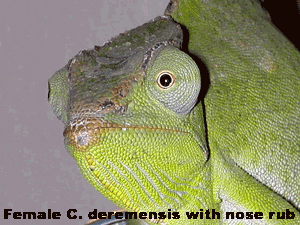
Quarantine
All newly acquired chameleons should be quarantined. This entails keeping new chameleons in a room, separated from the rest of your collection. Maintaining all new acquisitions away from your existing collection will help to ensure that cross contamination from parasites and diseases will not be an issue. Chameleons kept in quarantine should remain separated for a minimum of 60 days to insure that all pathogens are cleared from the system. Chameleons in quarantine should be cleaned, fed and watered after all of your other animals have been taken care of. Strict hand washing and sterilization procedures should be practiced while these animals remain in quarantine to avoid contamination.
Hydration
Water is perhaps the most important aspect of acclimating a chameleon. Re-hydration of the animal should be your first priority. Many keepers utilize misters, or misting systems to provide water and humidity. These methods are perfect for maintenance of established chameleons but often will fail to provide the amounts of water needed by a dehydrated chameleon. Showering is a method often utilized to re-hydrate a newly acquired chameleon. Showering a chameleon is a fairly simple process that is often relished by any chameleon as a way to not only re-hydrate but also to clean their eyes and skin. To shower your chameleon simply place a medium sized potted plant into your shower directing the spray on about one half of the plant. The water should be warm and gentle to simulate rain. Leaving the chameleon in the shower for 30-45 minutes will allow your chameleon time to drink and clear its eyes of any debris. Wild caught chameleons may require daily showering for several weeks in order to recover from the effects of collection and shipping while a captive born animal may only require periodic showers for maintenance purposes. In certain cases showering is not enough to help a severely dehydrated chameleon. In these cases, items like pedialyte and lactated ringers may be employed but only when used under the direction of a qualified veterinarian.
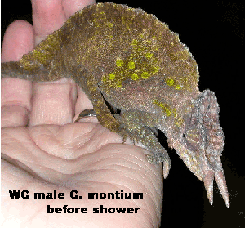
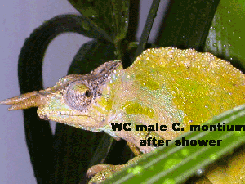
Parasites
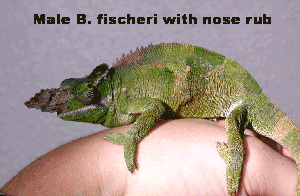
Parasites can be a death sentence for chameleons if left unchecked. All newly acquired chameleons, both wild caught and captive born should be checked for parasites. A fecal smear and/or float done by a qualified veterinarian will detect the presence of most parasites and an appropriate treatment can be suggested. A fresh fecal sample should be taken to a vet as soon as possible for diagnosis. In some species blood born parasites are more prevalent and must be diagnosed through blood tests. Treatments for these parasites should only be done under the supervision of a qualified veterinarian. “Shotgunning” or blanket treating of all chameleons with de-parasitizing drugs should be avoided in most situations. Keep in mind that many female chameleons that are wild caught come into the country gravid. Parasite treatment in gravid females can be a touchy subject and should not be attempted without the supervision of a qualified veterinarian.
Feeding

Feeding newly acquired chameleons can be tricky. Established animals are more likely to accept more diverse food items than newly acquired animals. Wild caught animals can be especially difficult to start on “standard” feeders such as crickets and mealworms. Items such as roaches, flies, moths and mantids will often trigger a greater feeding response than standard chameleon fare. Many species will be attracted to the movement and body shapes of these items and will begin to feed on their own. Field collected insects such as grasshoppers, katydids, and other wild insects will also be readily accepted. When field collecting insects, care must be exercised to insure they are captured in an area that has not been treated with insecticides or other chemicals. Dish feeding is usually not recommended for a newly acquired chameleon. Providing food ad-libitum provides visual stimulation and will often help a new chameleon begin feeding more quickly.
Caging
Caging for newly acquired animals should be approached with the same principles as any other chameleon. However, newly acquired animals may be stressed and shy. Providing a densely planted cage will provide ample hiding places. This will allow your new chameleon to slowly become acclimated to their new surroundings while still feeling secure and keeping the stress level low. Densely planted cages will also aid in the humidity level in the cage. Plants such as pothos, ficus and other leafy or vining plants are good choices for caging.
Acclimating a chameleon is not a difficult process as long as the needs of your new chameleon are met. Hydration, parasite treatment, caging and feeding are all important to the acclimation process. Observing your new chameleon’s actions and physical condition is paramount. The acclimation of wild caught chameleons is not a process to be undertaken by beginner or novice keepers. The needs and conditions that these chameleons arrive in, are far too advanced for many novice keepers to provide. It is always recommended that a first chameleon be a captive born specimen.

Jason Descamps

Jason Descamps has been keeping and breeding reptiles and amphibians for over 12 years. To date he has worked with over 135 species of reptiles including breeding 18 species of chameleons. His current focus is creating a stable captive chameleon gene pool through the CCBTD and working with rarely bred chameleon species such as C. (Tr.) weidersheimi, C. (Tr.) werneri, and C. (Tr.) fuelleborni. Jason served as an assistant editor for the Chameleons! Online E-Zine from December 2005 through February 2008.









Join Our Facebook Page for Updates on New Issues:
© 2002-2014 Chameleonnews.com All rights reserved.
Reproduction in whole or part expressly forbidden without permission from the publisher. For permission, please contact the editor at editor@chameleonnews.com
